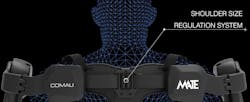Exoskeletons Will Bring Worker Centrality to the Factory of the Future
This article appeared in Electronic Design and has been published here with permission.
Since the First Industrial Revolution, manufacturers have used technology to make things better, faster and cheaper. Today, with the Fourth Industrial Revolution upon us, the focus has evolved from pure technology to the development of humanized technology.
As everything becomes increasingly connected within the new digital factory, Comau, part of the FCA Group, is leveraging its 45-year experience in industrial automation to deliver solutions that increase productivity and lower costs while ensuring the safety, health and sustainability of the workforce. It’s the human side of manufacturing, which is a fundamental element of the new smart factory paradigm.
Developing humanized technology implies interconnecting people, processes and production systems—what we can call HUMANufacturing—to create shared intelligence and exploit real-time data analysis. On average, the optimization of manufacturing processes using analytics and digital technologies can help increase overall productivity by up to 3% to 5%.
Another benefit of HUMANufacturing is right-sized automation. By working closely with customers to identify and implement an ideal mix of automated and human skills, they avoid over-automating or over-staffing their factories. Industrial machines are only used where needed; the operators and machines can carry out only the tasks they perform best.
This intimate knowledge of process dynamics and workflow optimization allows automation products and solutions providers to help industries of all sizes leverage the benefits of future-focused automation. In some cases, this involves allowing industrial robots to work safely and securely alongside operators directly inside the production line or using advanced technology to assist humans during repetitive manual tasks. It can also mean using technology to perform dangerous or mundane work and allow human operators to focus their talents on value-added activities.
Through an ongoing commitment to R&D, joint project management and advanced engineering, advanced industrial automation products and solutions are spearheading a better balance between the use of technology and the contribution of the operator as a central, fundamental figure within the industrial process. In doing so, they’re helping customers exploit the full potential of flexible manufacturing and increasing competitiveness.
Smart Manufacturing through Exoskeletons
Assisting humans as they perform manual and repetitive tasks is a key aspect of smart manufacturing in light of two important considerations: a globally aging workforce and the physical fatigue that comes with manual and repetitive manufacturing tasks. Exoskeletons are the emblem of worker centrality within the factory of the future to help companies respond to this challenge.
For example, Comau’s exoskeleton MATE has been conceived with a user-centered design approach—workers have been involved since the beginning of the design process and their needs and suggestions have driven the development process. It was then developed in collaboration with ÖSSUR, a leading non-invasive orthopedic company, and IUVO, a spin-off of the Italian BioRobotics Institute specializing in wearable technologies.
MATE is a tangible example of how wearable technology can support workers in many sectors, including construction, domestic appliances, agriculture, services and automotive. The benefits for the worker, such as improved workplace comfort, reduced muscle effort and, as a result, improved quality of work life, are combined with indirect benefits for the whole of society, starting with the welfare of the workforce by companies.
MATE, passive technology exoskeleton that doesn’t require batteries or motors, complies with all shoulder physiological movements, without resistance or misalignment. This allows for a comfortable interaction and avoids undesired and risky overloads.
Lightweight, breathable, and ergonomically designed to adhere to the body like a second skin, the wearable exoskeleton provides consistent and advanced antigravitational arm’s assistance during manual and repetitive strenuous tasks. By moving with its wearer and effectively transferring weight away from the operator’s shoulders, it generates a 30% reduction in physical strain on the main shoulder muscles. In this way, it helps reduce the strain of performing overhead. Check out this video:
Although some of the work in factories is automated, human input is still crucial and remains at the heart of many operations, including value-added and repetitive ones that require a high level of precision.
By delivering powerful movement assistance when and where it’s needed, it can be used for all overhead tasks, including assembling, gluing, drilling, painting, operating vibrating hand tools, material manipulation, and retrieving products from high shelves or conveyor lines, as well as during commercial and recreational activities. The result is a reduced muscular effort, improved posture, and improved overall well-being.
Exoskeletons in workplaces have become more common in several industries since 1965, when the first exoskeleton was produced for military use. Their popularity has particularly increased in the manufacturing world, supporting workers and improving the quality of their working hours. In 2018, more than 7,000 units were sold in manufacturing (ABI Research data), but the potential market need would be over 60,000 units for all types of exoskeletons, with an estimated growth rate of more than 50% from 2019 to 2024. A trend that, considering the increasing average age of population in industrialized countries, could grow again.
Elena Corsi is product marketing manager, Robotics and Automation Products, at Comau.

